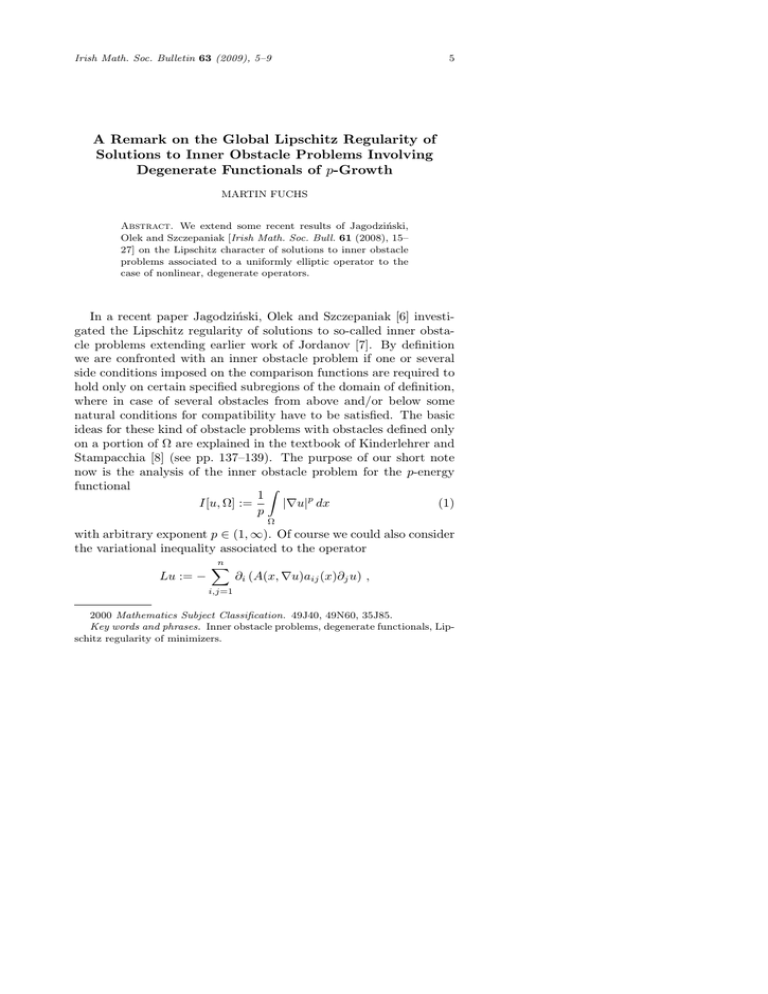A Remark on the Global Lipschitz Regularity of
advertisement

Irish Math. Soc. Bulletin 63 (2009), 5–9
5
A Remark on the Global Lipschitz Regularity of
Solutions to Inner Obstacle Problems Involving
Degenerate Functionals of p-Growth
MARTIN FUCHS
Abstract. We extend some recent results of Jagodziński,
Olek and Szczepaniak [Irish Math. Soc. Bull. 61 (2008), 15–
27] on the Lipschitz character of solutions to inner obstacle
problems associated to a uniformly elliptic operator to the
case of nonlinear, degenerate operators.
In a recent paper Jagodziński, Olek and Szczepaniak [6] investigated the Lipschitz regularity of solutions to so-called inner obstacle problems extending earlier work of Jordanov [7]. By definition
we are confronted with an inner obstacle problem if one or several
side conditions imposed on the comparison functions are required to
hold only on certain specified subregions of the domain of definition,
where in case of several obstacles from above and/or below some
natural conditions for compatibility have to be satisfied. The basic
ideas for these kind of obstacle problems with obstacles defined only
on a portion of Ω are explained in the textbook of Kinderlehrer and
Stampacchia [8] (see pp. 137–139). The purpose of our short note
now is the analysis of the inner obstacle problem for the p-energy
functional
Z
1
I[u, Ω] :=
|∇u|p dx
(1)
p
Ω
with arbitrary exponent p ∈ (1, ∞). Of course we could also consider
the variational inequality associated to the operator
n
X
∂i (A(x, ∇u)aij (x)∂j u) ,
Lu := −
i,j=1
2000 Mathematics Subject Classification. 49J40, 49N60, 35J85.
Key words and phrases. Inner obstacle problems, degenerate functionals, Lipschitz regularity of minimizers.
6
Martin Fuchs
where aij (x) are smooth elliptic coefficients and where we have abn
P
p
breviated A(x, ∇u) := (
aαβ (x)∂α u∂β u) 2 −1 , but this would not
α,β=1
lead to a deeper insight. Note that in the above cited papers the case
p = 2 is considered. For simplicity we also just discuss the case of
one inner obstacle (from below): in the presence of several inner
constraints the arguments of [6] have to be modified in an obvious
way, which in particular means that we have to impose the same
natural assumptions of compatibility on the functions acting as side
conditions and on their domains of definitions as done in [6].
Next we give a precise formulation of our hypotheses concerning
the data: let Ω denote a bounded, open set in Rn whose boundary
can locally be represented as a graph of a function with Hölder continuous derivatives. Suppose further that ω is an open subset of Ω
with ∂ω being of the same regularity as ∂Ω and such that ω ⊂ Ω.
Let us consider a function Ψ ∈ C 1,α1 (ω) for some α1 ∈ (0, 1) and
define the class of comparison functions
◦
K := {w ∈W 1p (Ω) : w ≥ Ψ
a.e. on ω} ,
(2)
◦
where W 1p (Ω) is the usual Sobolev space of functions vanishing on
∂Ω as introduced for example in [1]. Then we have following result:
Theorem 1. The inner obstacle problem I[ · , Ω] → min in K with
I[ · , Ω] and K being defined in (1) and (2) admits a unique solution
u ∈ K. The function u is globally Lipschitz, moreover we have u ∈
C 1,α (Ω − (∂ω)ε ) for some α ∈ (0, 1), (∂ω)ε denoting the set {x ∈ Ω :
dist (x, ∂ω) < ε}.
Proof. Since K 6= ∅, the existence and the uniqueness of a minimizer u is immediate, and clearly u is the solution of the variational
inequality
Z
|∇u|p−2 ∇u · ∇(v − u) dx ≥ 0 ∀v ∈ K .
(3)
Ω
As done in [6] we will reduce (3) to a global obstacle problem with
e : Ω → R. To this purpose consider the
a suitable constraint Ψ
minimization problem
I[w, Ω − ω] → min, w ∈ C ,
(4)
Solutions to Inner Obstacle Problems
7
where C := {w ∈ Wp1 (Ω − ω) : w|∂Ω = 0 and w|∂ω = Ψ}, and let h
denote the unique solution of (4). We further define
◦
h on Ω − ω ,
e :=
Ψ
∈W 1p (Ω)
Ψ on ω
◦
e = {w ∈W 1 (Ω) : w ≥ Ψ
e a.e. on Ω}
and introduce the “global” class K
p
as well as the “global” problem
e.
I[ · , Ω] → min in K
(5)
If u
e ∈ K denotes the unique solution of (5), we claim the validity of
u=u
e.
(6)
In fact, u
e is admissible in (3), i.e. we have
Z
|∇u|p−2 ∇u · ∇(e
u − u) dx ≥ 0 .
(7)
Ω
(5) is equivalent to the variational inequality
Z
e.
|∇e
u|p−2 ∇e
u · ∇(w − u
e) dx ≥ 0 ∀w ∈ K
(8)
Ω
We like to insert u into (8), which means that we have to check that
u≥h
on Ω − ω
(9)
holds. From (3) it follows
Z
◦
|∇u|p−2 ∇u · ∇ϕ dx ≥ 0 ∀ϕ ∈W 1p (Ω − ω), ϕ ≥ 0 ,
(10)
Ω−ω
whereas we get from (4)
Z
◦
|∇h|p−2 ∇h · ∇ϕ dx = 0 ∀ϕ ∈W 1p (Ω − ω) .
(11)
Ω−ω
◦
The function ϕ := max{h − u, 0} is inR the space W 1p (Ω − ω) and for
this choice of ϕ (10) and (11) imply M [|∇u|p−2 ∇u − |∇h|p−2 ∇h] ·
∇(h − u) dx ≥ 0 , M := (Ω − ω) ∩ [h > u], which by the coercivity of
the field Rn 3 ξ 7→ |ξ|p−2 ξ immediately gives ∇ϕ = 0 a.e. on Ω − ω,
i.e., ϕ = 0 on this set, so that (9) follows. But then we combine (7)
with (8) choosing w = u and arrive at (6).
From the works of e.g. Evans [5], Di Benedetto [3], Lieberman [9],
Manfredi [11, 12] and Tolksdorf [14] we deduce that the solution h of
8
Martin Fuchs
problem (4) is of class C 1,α (Ω − ω) for some α ∈ (0, 1), in particular
there is a finite constant K such that
|∇h| ≤ K
a.e. on Ω − ω .
(12)
∞
According to our assumptions |∇Ψ| is in the space L (ω) so that on
e is Lipschitz on the whole domain Ω. (Note that
account of (12) Ψ
we can not guarantee the validity of ∇h = ∇Ψ on ∂ω, which means
e is in C 1,α (Ω).) This is enough to apply
that we do not know if Ψ
Theorem 1.2 of [2] with the result that the solution u
e of (5) and
thereby u (recall (6)) is locally Lipschitz in Ω. The C 1,α - regularity
of u on the sets Ω − (∂ω)ε is consequence of the works of e.g. Choe
and Lewis [4], Lieberman [10] or Mu and Ziemer [13]. This completes
the proof of the Theorem, since obviously |∇u| ∈ L∞
loc (Ω) together
with u ∈ C 1,α (Ω − (∂ω)ε ) implies |∇u| ∈ L∞ (Ω).
Remark 1. If we replace
R the energy from (1) by a more general
functional J[w, Ω] := f (∇w) dx, where f should at least satisfy
Ω
the hypotheses of Theorem 1.2 in [2], then again the global Lipschitz
regularity of the minimizer will follow as soon as we can guarantee
the global boundedness of |∇h|, h being the solution of problem (4)
now formulated for the functional J.
Remark 2. If we assume that Ψ ≥ 0 on ω and if we consider the
discontinuous obstacle
Ψ on ω ,
Ψ̂ :=
0 on Ω − ω ,
then it is easy to see that the solution u of the problem
I[ · , Ω] → min in K
coincides with the unique solution û of
I[ · , Ω] → min in K̂ ,
◦
K̂ := {w ∈W 1p (Ω) : w ≥ Ψ̂
a.e. on Ω} .
References
[1] R. A. Adams, Sobolev spaces, Academic Press, New York–San Francisco–
London, 1975.
[2] M. Bildhauer, M. Fuchs, G. Mingione, A priori gradient bounds and local
C 1,α -estimates for (double) obstacle problems under nonstandard growth
conditions, Z. Anal. Anw. 20, no.4 (2001), 959–985.
Solutions to Inner Obstacle Problems
9
[3] E. Di Benedetto, C 1,α local regularity results of solutions of nonlinear degenerate elliptic equations, Nonlinear Analysis, TMA, 7 (1983), 827–850.
[4] H. J. Choe, J. L. Lewis, On the obstacle problem for quasilinear elliptic
equations of p-Lalacian type, SIAM J. Math. Anal. 22, no 3, (1991), 623–
638.
[5] L. C. Evans, A new proof of local C 1,α regularity for solutions of certain
degenerate P. D. E. s, J. Diff. Equ. 45 (1982), 356–373.
[6] S. Jagodziński, A. Olek, K. Szczepaniak, Lipschitz character of solutions to
the inner obstacle problem, Irish Math. Soc. Bull. 61 (2008), 15–27.
[7] J. Jordanov, Solutions holderiennes d’inequations variationelles a constraines discontinuous, Serdica 8 (1982), 296–306.
[8] D. Kinderlehrer, G. Stampacchia, An introduction to variational inequalities
and their applications, Academic Press, New York–London, 1980.
[9] G. Lieberman, Boundary regularity for solutions of degenerate elliptic equations, Nonlinear Analysis, TMA, 12 (1988), 1203–1219.
[10] G. Lieberman, Regularity of solutions to some degenerate double obstacle
problems, Indiana Univ. Math. J. 40 (1991), 1009–1028.
[11] J. Manfredi, Regularity of the gradient for a class of nonlinear possibly
degnerate equations, PhD thesis, Washington Univ. 1986.
[12] J. Manfredi, Regularity for minima of functionals with p-growth,
J. Diff. Equ. 76 (1988), 203–212.
[13] J. Mu, W. P. Ziemer, Smooth regularity of solutions of double obstacle
problems involving degenerate elliptic equations, Comm. P. D. E. 16 (485)
(1991), 821–843.
[14] P. Tolksdorf, Regularity for a more general class of elliptic equations,
J. Diff. Equ. 51 (1984), 126–150.
Martin Fuchs,
Department of Mathematics,
Saarland University,
P.O. Box 15 11 50,
D-66041 Saarbrücken, Germany
fuchs@math.uni-sb.de
Received on 21 April 2009.





